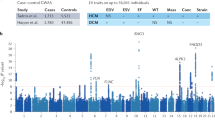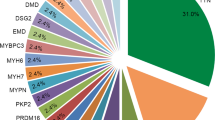Abstract
The marked clinical and genetic heterogeneity seen in hypertrophic (HCM) and dilated cardiomyopathies (DCM) suggests involvement of disease modifiers and environmental factors in the pathophysiology of these diseases. In the current study, we examined association of single nucleotide polymorphisms (SNPs) of three candidate genes, ACE2 (rs6632677), TNNI3K (rs49812611) and CALM3 (rs13477425) with clinical phenotypes of HCM and DCM patients of North Indian ethnicity. Prevalence of ACE2 (7160726 C>G) variant genotypes (CG and GG) was significantly higher in DCM subjects as compared to controls. Prevalence of TNNI3K (3784 C>T) and CALM3 (−34T>A) variant homozygous genotype were significantly higher in HCM and DCM subjects as compared to controls. DCM patients with CT genotype showed significant decrease in LVEF as compared to CC genotype (p < 0.03). There was significant gene–gene interaction between these SNPs and three-way SNP combination of ACE2 C>G, TNN13K C>T, CALM3 A>T gene variants and was associated with high risk of HCM and DCM. Presence of ACE2 (7160726 C>G) and CALM3 (−34T>A) variant genotypes in HCM Patients with mutations (sarcomeric or non sarcomeric genes) was associated with increased mean septal thickness, further suggesting a role of these gene variants in modifying disease phenotype. Our results suggest that ACE2, TNNI3K and CALM3 polymorphisms are associated with increased risk of HCM and DCM and may act as disease modifiers of these diseases.



Similar content being viewed by others
Change history
28 November 2018
In the original publication of the article, the location and rs number of TNNI3K mouse SNP (3784 C>T) (rs49812611) has been mentioned inadvertently in place of its human homologue. The correct information for human SNP is rs760769780 located at position 74436534, resulting in (G>A) change in human TNNI3K gene.
28 November 2018
In the original publication of the article, the location and rs number of TNNI3K mouse SNP (3784 C>T) (rs49812611) has been mentioned inadvertently in place of its human homologue. The correct information for human SNP is rs760769780 located at position 74436534, resulting in (G>A) change in human TNNI3K gene.
References
Marian AJ (2002) Modifier genes for hypertrophic cardiomyopathy. Curr Opin Cardiol 17:242–252
Adzhubei IA, Schmidt S, Peshkin L, Ramensky VE, Gerasimova A, Bork P et al (2010) A method and server for predicting damaging missense mutations. Nat Methods 4:248–249
Daw EW, Chen SN, Czernuszewicz G, Lombardi R, Lu Y, Ma J et al (2007) Genome-wide mapping of modifier chromosomal loci for human hypertrophic cardiomyopathy. Hum Mol Genet 16:2463–2471
Lechin M, Quinones MA, Omran A, Hill R, Yu QT, Rakowski H et al (1995) Angiotensin-I converting enzyme genotypes and left ventricular hypertrophy in patients with hypertrophic cardiomyopathy. Circulation 92:1808–1812
Wang SX, Fu CY, Zou YB, Wang H, Shi Y, Xu XQ et al (2008) Polymorphisms of angiotensin-converting enzyme 2 gene associated with magnitude of left ventricular hypertrophy in male patients with hypertrophic cardiomyopathy. Chin Med J (Engl) 121:27–31
Friedrich FW, Bausero P, Sun Y, Treszl A, Kramer E, Juhr D et al (2009) A new polymorphism in human calmodulin III gene promoter is a potential modifier gene for familial hypertrophic cardiomyopathy. Eur Heart J 30:1648–1655
Wheeler FC, Tang H, Marks OA, Hadnott TN, Chu PL, Mao L et al (2009) Tnni3k modifies disease progression in murine models of cardiomyopathy. PLoS Genet 5:e1000647
Gill P, Werrett DJ (1987) Exclusion of a man charged with murder by DNA fingerprinting. Forensic Sci Int 35:145–148
Hahn LW, Ritchie MD, Moore JH (2003) Multifactor dimensionality reduction software for detecting gene–gene and gene–environment interactions. Bioinformatics 19:376–382
Ahmad F, Seidman JG, Seidman CE (2005) The genetic basis for cardiac remodeling. Annu Rev Genom Hum Genet 6:185–216
Danilczyk U, Eriksson U, Crackower MA, Penninger JM (2003) A story of two ACEs. J Mol Med (Berl) 81:227–234
Morimoto S (2008) Sarcomeric proteins and inherited cardiomyopathies. Cardiovasc Res 77:659–666
Zhao Y, Meng XM, Wei YJ, Zhao XW, Liu DQ, Cao HQ et al (2003) Cloning and characterization of a novel cardiac-specific kinase that interacts specifically with cardiac troponin I. J Mol Med (Berl) 81:297–304
Wang H, Wang L, Song L, Zhang YW, Ye J, Xu RX et al (2013) TNNI3K is a novel mediator of myofilament function and phosphorylates cardiac troponin I. Braz J Med Biol Res 46:128–137
Hannigan GE, Coles JG, Dedhar S (2007) Integrin-linked kinase at the heart of cardiac contractility, repair, and disease. Circ Res 100:1408–1414
Lu H, Fedak PW, Dai X, Du C, Zhou YQ, Henkelman M et al (2006) Integrin-linked kinase expression is elevated in human cardiac hypertrophy and induces hypertrophy in transgenic mice. Circulation 114:2271–2279
Chiu C, Tebo M, Ingles J, Yeates L, Arthur JW, Lind JM et al (2007) Genetic screening of calcium regulation genes in familial hypertrophic cardiomyopathy. J Mol Cell Cardiol 43:337–343
Colomer J, Agell N, Engel P, Bachs O (1994) Expression of calmodulin and calmodulin binding proteins in lymphoblastoid cells. J Cell Physiol 159:542–550
Li Q, Gruner C, Chan RH, Care M, Siminovitch K, Williams L et al (2014) Genotype-positive status in patients with hypertrophic cardiomyopathy is associated with higher rates of heart failure events. Circ Cardiovasc Genet 7:416–422
Maron BJ, Maron MS, Semsarian C (2012) Double or compound sarcomere mutations in hypertrophic cardiomyopathy: a potential link to sudden death in the absence of conventional risk factors. Heart Rhythm 9:57–63
Acknowledgements
Amit Kumar received Senior Research Fellowship from Indian Council of Medical Research (ICMR), New Delhi, India.
Statement of authorship
The authors take responsibility for all aspects of the reliability and freedom from any bias of the data presented and their discussed interpretation.
Author information
Authors and Affiliations
Corresponding author
Ethics declarations
Conflict of interest
The authors declare that there is no conflict of interest.
Rights and permissions
About this article
Cite this article
Kumar, A., Rani, B., Sharma, R. et al. ACE2, CALM3 and TNNI3K polymorphisms as potential disease modifiers in hypertrophic and dilated cardiomyopathies. Mol Cell Biochem 438, 167–174 (2018). https://doi.org/10.1007/s11010-017-3123-9
Received:
Accepted:
Published:
Issue Date:
DOI: https://doi.org/10.1007/s11010-017-3123-9




